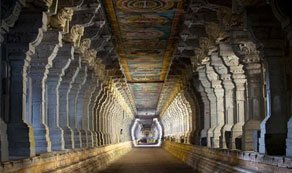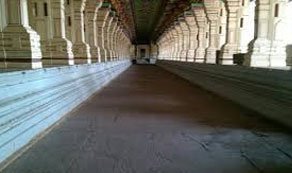The Ramanathaswamy Temple and its Infinite Corridors

The Ramanathaswamy Temple and its Infinite Corridors:
The Ramanathaswamy Temple is regarded as one of the holiest Hindu temples in India. This sacred site is located on Rameswaram Island, in the southern Indian state of Tamil Nadu between mainland India and Sri Lanka. The Ramanathaswamy Temple, which is dedicated to the god Shiva, is notable for a variety of reasons, including its outer set of corridors, which are reputed to be the longest of their kind in the world.
Legends of the Temple:
There are a number of legends about the origin of the Ramanathaswamy Temple. One of these states that the temple was built on the site where a lingam (an abstract representation of Shiva) of sand was built by Rama, the hero of the Ramayana, and an avatar of Vishnu. The story goes that as Rama was on his way to attack Ravana on the island fortress of Lanka, he stopped by the seashore to have a drink. As he was doing so, a voice came from the heavens telling Rama that he was drinking water without having first worshipped the relevant deity.
Recognising that the voice belonged to Shiva, Rama made a lingam of sand, and worshipped it. The hero also asked for Shiva’s blessing, so that he may vanquish Ravana, which was granted. Finally, Rama requested Shiva to reside eternally at that spot, so that mankind may benefit from it. Shiva agreed to this as well, transformed himself into the lingam which is now housed in the temple.
Humble Beginnings:
As for the temple itself, the first structure is recorded to have been a thatched hut. In the centuries that followed, different parts of the temple were commissioned and built by the rulers of the island. During the 12 th century, the sanctum around the Ramanathaswamy Temple was constructed by Parakramabahu I, a king of Polonnaruwa (located in modern day Sri Lanka). The most important dynasty in the building history of the Ramanathaswamy Temple, however, was the Sethupathi Dynasty, who ruled over Ramnad and Sivaganga during the 17 th century.
The temple in its current form is believed to have been built during the 17th century, while Fergusson believes the small vimana in the west corridor belongs to the 11th or 12th century. The temple is said to have been sanctioned for construction by King Kizhavan Sethupathi or Raghunatha Kilavan.
The third corridor, also known as ChokkatanMandapam, is the largest temple corridor in the world with 1212 pillars – each pillar measuring 30 feet. It resembles a gigantic chess board. This is where you will find the deities called Utsava. There are two gopurams, one located in the east and one located in the west.
The Ramanatha Swamy temple, the largest in the town of Rameshwaram is spread over a whopping 15 acres and is ornate, large and awe inspiring all at once. An important pilgrimage center, this temple houses one of the twelve jyotirlingas in the country. Steeped in mythology, there is literally a story behind every idol and place here. This apart, the temple is renowned for its extremely long corridors. There are three huge corridors in all here. The first corridor is the oldest and dates back to the 12th century, but has been renovated over various time periods and houses the main deity. The second corridor has 108 shiva lingas as well as a statue of Ganapathi.
The third corridor is the show stopper with a whopping 1212 pillars set on an elevated platform and has a height of close to 23 feet and is naturally said to be the longest pillared corridor in the world. Interestingly, these carved granite pillars are not available locally and are believed to have been brought in from some other part of Tamil Nadu. The carvings on these pillars are quite mind boggling and have been painted in bright colours as part of the regular maintenance and make for a compelling visual – one that will stay will you even after you leave this place.









